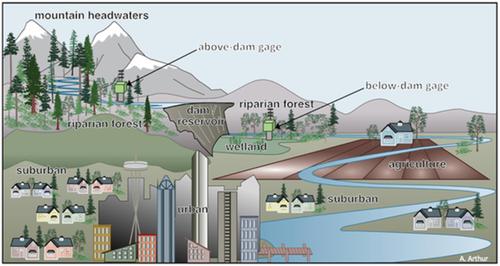当前位置:
X-MOL 学术
›
Hydrol. Process.
›
论文详情
Our official English website, www.x-mol.net, welcomes your
feedback! (Note: you will need to create a separate account there.)
River management response to multi‐decade changes in timing of reservoir inflows, Columbia River Basin, USA
Hydrological Processes ( IF 2.8 ) Pub Date : 2020-09-17 , DOI: 10.1002/hyp.13910 Julia A. Jones 1 , John C. Hammond 2
Hydrological Processes ( IF 2.8 ) Pub Date : 2020-09-17 , DOI: 10.1002/hyp.13910 Julia A. Jones 1 , John C. Hammond 2
Affiliation

|
Around the world, long‐term changes in the timing and magnitude of streamflow are testing the ability of large managed water resource systems constructed in the 20th century to continue to meet objectives in the 21st century. Streamflow records for unregulated rivers upstream of reservoirs can be combined with records downstream of reservoirs using a paired‐watershed framework and concepts of water resource system performance to assess how reservoir management has responded to long‐term change. Using publicly available data, this study quantified how the intra‐annual timing of inflows and outflows of 25 major reservoirs has shifted, how management has responded, and how this has influenced reliability and vulnerability of the water resource system in the 668,000 km2 Columbia River basin from 1950 to 2012. Reservoir inflows increased slightly in early spring and declined in late spring to early fall, but reservoir outflows increased in late summer from 1950 to 2012. Average inflows to reservoirs in the low flow period exceeded outflows in the1950s, but inflows are now less than outflows. Reservoirs have increased hedging, that is, they have stored more water during the spring, in order to meet the widening gap between inflows and outflows during the summer low flow period. For a given level of reliability (the fraction of time flow targets were met), vulnerability (the maximum departure from the flow target) was greater during periods with lower than average inflows. Thus, the water management system in this large river basin has adjusted to multi‐decade trends of declining inflows, but vulnerability, that is, the potential for excess releases in spring and shortfalls in summer, has increased. This study demonstrates the value of combining publicly available historical data on streamflow with concepts from paired‐watershed analyses and metrics of water resource performance to detect, evaluate, and manage water resource systems in large river basins.
中文翻译:

美国哥伦比亚河流域,河流管理对水库入库时间变化的数十年响应
在世界范围内,水流的时间和大小的长期变化正在测试20世纪建造的大型可管理水资源系统继续满足21世纪目标的能力。可以使用成对的分水岭框架和水资源系统性能的概念,将水库上游不受管制的河流的水流记录与水库下游的记录相结合,以评估水库管理如何响应长期变化。利用公开可用的数据,本研究量化了25个主要水库的年内流入和流出时间如何变化,管理如何做出反应以及这如何影响了668,000 km 2的水资源系统的可靠性和脆弱性。1950年至2012年是哥伦比亚河流域。1950年至2012年,水库入库流量在早春略有增加,而在春末至初秋有所减少,但在夏末从1950年至2012年却增加了。但现在的流入量少于流出量。水库增加了套期保值,也就是说,它们在春季存储了更多的水,以适应夏季低流量时期流入和流出之间不断扩大的缺口。对于给定的可靠性水平(达到了流量目标的时间比例),脆弱性(与流量目标的最大偏离)在低于平均流入量的时期内更大。因此,这个大流域的水管理系统已经适应了数十年来流入量减少的趋势,但是脆弱性,即 春季过度释放和夏季短缺的可能性增加了。这项研究证明了将公开可用的水流历史数据与成对分水岭分析的概念和水资源绩效指标相结合,以检测,评估和管理大型流域水资源系统的价值。
更新日期:2020-09-17
中文翻译:

美国哥伦比亚河流域,河流管理对水库入库时间变化的数十年响应
在世界范围内,水流的时间和大小的长期变化正在测试20世纪建造的大型可管理水资源系统继续满足21世纪目标的能力。可以使用成对的分水岭框架和水资源系统性能的概念,将水库上游不受管制的河流的水流记录与水库下游的记录相结合,以评估水库管理如何响应长期变化。利用公开可用的数据,本研究量化了25个主要水库的年内流入和流出时间如何变化,管理如何做出反应以及这如何影响了668,000 km 2的水资源系统的可靠性和脆弱性。1950年至2012年是哥伦比亚河流域。1950年至2012年,水库入库流量在早春略有增加,而在春末至初秋有所减少,但在夏末从1950年至2012年却增加了。但现在的流入量少于流出量。水库增加了套期保值,也就是说,它们在春季存储了更多的水,以适应夏季低流量时期流入和流出之间不断扩大的缺口。对于给定的可靠性水平(达到了流量目标的时间比例),脆弱性(与流量目标的最大偏离)在低于平均流入量的时期内更大。因此,这个大流域的水管理系统已经适应了数十年来流入量减少的趋势,但是脆弱性,即 春季过度释放和夏季短缺的可能性增加了。这项研究证明了将公开可用的水流历史数据与成对分水岭分析的概念和水资源绩效指标相结合,以检测,评估和管理大型流域水资源系统的价值。











































 京公网安备 11010802027423号
京公网安备 11010802027423号